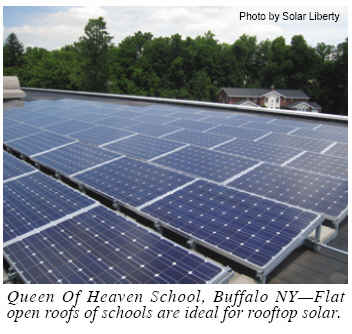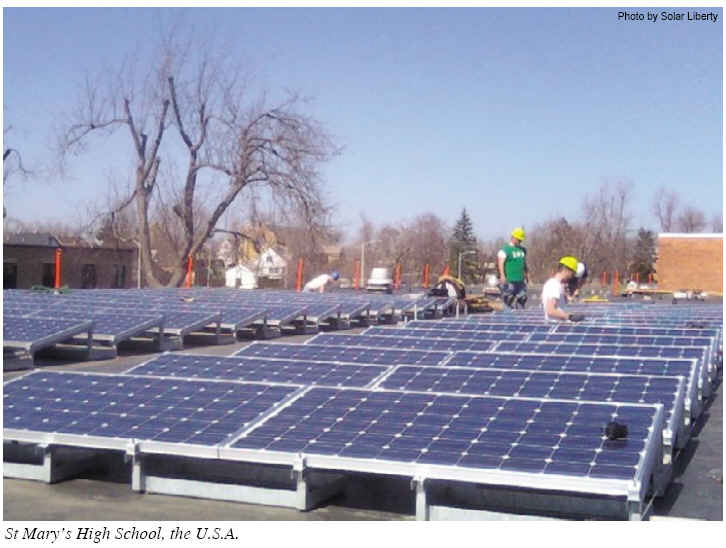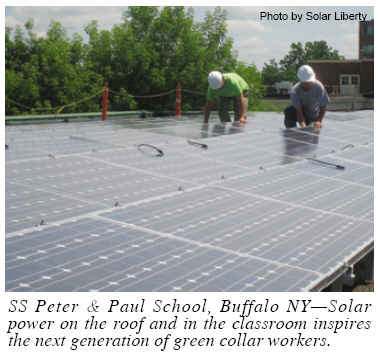By Jim Walters, Karen Beck


Solar, Reasons to be Optimistic
The strong majority, nearly 9 in 10 adult Americans support the development of solar energy. We all know that clean energy is good for the environment because it doesn¡¯t carry the carbon dioxide ¡°baggage¡± of other sources. We also understand that a diversified energy mix is critical to America¡¯s energy independence and continuity.
Yet, less than 1% of our energy in the United States comes from our most powerful energy source: the sun. So, what¡¯s the holdup? Economic factors? Regulatory issues? Supply issues? Lack of understanding on how to make solar a reality?
To be fair, all of these factors have played a part in the last decade in slowing the wide-scale adoption of solar or other renewable energy sources in the United States. However, solar is at an important inflection point--the next decade will be much different than the last in achieving measurable environmental, social and economic benefit.
Let¡¯s discuss a number of reasons to be optimistic, including but not limited to.
Unprecedented Collaboration between Public Sector, Private Industry and Financial Community
State officials and private industry are working together to tear down the barriers that have precluded wide-scale solar development. In unprecedented collaboration, leaders from both sectors are mapping out solutions to move solar forward, even in advance of price parity with traditional ¡°peaker¡± power plants.
More and more states are providing ¡°bridge incentives¡± to accelerate the adoption of solar--incentives that make it financially beneficial for organizations to build solar energy systems on unused rooftops and vacant land. In addition, the government is setting goals and ¡°renewable portfolio standards¡± for utilities to increase the percentage of electricity generated through renewable energy sources.
To meet government standards, solar experts and developers are joining forces to deliver innovative solutions that increase solar production and financial benefit. Seeming competitors are joining forces to leverage the best technologies, approach and expertise in bringing projects to fruition. What¡¯s more, leading developers have established strong ties with the financial community to fund solar project installations, enabling them to offer creative, long-term financing options such as the Power Purchase Agreement, under which participating organizations pay nothing up-front for solar project deployment.
Financial institutions, like their public and private sector partners, recognize that solar is not only a good financial investment, but a necessity for our energy future. Nowhere is this trend more evident than with the ground-breaking joint venture between solar energy services company SunEdison and First Reserve Bank announced last month, whereby US$1.5 billion has been set aside for current and future SunEdison solar photovoltaic energy projects.
Grid Parity within Reach
In order to reach grid parity--the point at which the cost of solar electricity is equal to that generated by traditional ¡°peaker¡± power plants--demand for solar generated energy needs to increase. The measures above will go a long way toward closing the price gap.
However, there are two other macro-trends that will play a part in making solar the energy source of choice--even without government incentives. First, the cost of solar is rapidly declining, largely due to drops in the price of silicon wafers which is the material ingredient of solar panels and conductors. Second, the cost of electricity from traditional sources continues to rise. Expert opinion varies based on when the two lines will cross, but almost all agree that we¡¯ll get there within the next decade.
This, of course, is predicated on the investments we¡¯re making now in promoting and scaling solar. We cannot afford to take our eye off the prize. The long-term payoff will be tremendous--for the environment, for our economy, for national security, for the health of future generations.
Green Schools & Greener Students
 Solar adoption is picking up in all sectors, and indicators support the fact that solar project development will continue to grow among commercial organizations, utilities, government entities and schools alike. Among these sectors, however, perhaps the most exciting movement exists among schools. Why? Because usage of solar energy by schools touches the generation of citizenswho will lead the clean energy charge in the years ahead. Solar adoption is picking up in all sectors, and indicators support the fact that solar project development will continue to grow among commercial organizations, utilities, government entities and schools alike. Among these sectors, however, perhaps the most exciting movement exists among schools. Why? Because usage of solar energy by schools touches the generation of citizenswho will lead the clean energy charge in the years ahead.
¡°Going green¡± is not just a short-term fad among American schools and universities. It¡¯s become a core feature of the institutional vision. In 2009, the U.S. Green Building Council (USGBC) created a special category of its LEED rating system for education. The new ¡°LEED for Schools¡± promotes the perspective that green schools are healthier places to learn and work. The USGBC promotes sustainable building through improved energy and water efficiency, indoor air quality, and using greener building materials. The organization cites studies that demonstrate how greener schools improve the health and performance of both students and faculty. Students learn better and miss fewer days, while their teachers are more productive and content in the workplace. Green schools retain teachers.
The state of Washington in 2005 signed into law the ¡°The High-Performance Public Buildings Act¡±. Among the state¡¯s new mandates is that all major facility projects of public school districts receiving any funding in a state capital budget must be designed and constructed to at least the LEED silver standard or the Washington sustainable school design protocol. Adding a solar energy system to a building is one of the most impactful improvements on a building¡¯s LEED rating.
Another example of the movement toward green schools is the 2010-2011 Princeton Review¡¯s Guide to 286 Green Colleges, which helps prospective college students shop for their university based on green qualifications. Solar is already the most common renewable energy application on universities--an important differentiator in increasingly competitive education industry.
Worldwide prices of solar modules closely follow demand. With over 100,000 schools in the United States, many of which have traditional flat roof constructions, across the board policies like Washington State¡¯s would have a real impact on solar market prices. The rate of adoption of solar energy to power our buildings is influenced by both attitudes and economics; putting solar arrays on thousands of school rooftops will make the technology more desirable and affordable.

Case Studies: Schools Go Solar
Schools Go Solar in Western New York
One of the most progressive school systems in the United States in terms of solar power is the Catholic Diocese of Buffalo¡¯s system of private primary and secondary schools. More than 1.3 MW of on-site solar power is on 43 of their school roofs. The project is expected to save the school system more than US$175,000 in energy costs in the first year of operation and cut the Diocese¡¯s carbon emissions by 50 million pounds over the 25 year warrantied lifetime of the of the solar panels.
¡°I¡¯m excited to see that so many of our schools have chosen to participate in this program with Solar Liberty. The students at these schools will enjoy on-site access to an incomparable educational opportunity. This is just one of many ways they will learn to incorporate renewable energy into their lives, said Viki Ingersoll, Energy Manager of the Catholic Diocese of Buffalo. ¡°Not only will these systems contribute to environmental sustainability in our region, but the cost savings will also contribute to the financial stability of our schools in the years ahead.¡± Solar Liberty, the Buffalo, NY-based solar integrator installing the diocese project, has made the education market its specialty. The company is installing over 3 MW of solar on more than 65 school projects in New York State. Many of the systems are rooftop installations. However, some schools have creating more elaborate ground mount arrays to emphasize the central place that renewable energy play in for the students and the institution. The State University of New York at Buffalo¡¯s project is designed to arrange 5,000 solar panels in the shape of a DNA strand. It emphasizes the university¡¯s high-profile focus on bio informatics.
Adam Rizzo, president of Solar Liberty sees solar schools as part of the big picture of solar becoming mainstream. ¡°It¡¯s all part of a cycle,¡± Rizzo explained. ¡°These students see solar as an everyday part of life. Young people are surrounded by new technology that they quickly take for granted. Solar is no different.¡±
Montgomery County Schools Go Solar in Mid-Atlantic
Another progressive school district just minutes from the Nation¡¯s capital, Montgomery County Schools, recently celebrated the activation of eight photovoltaic power systems totaling 1.1 MW of solar capacity. Combined, the systems will produce over 1.3 million kilowatt hours (kWh) annually and over 25 million kilowatt hours (kWh) over the first 20 years of operation.
The environmental attributes associated with the eight solar arrays will offset over 48 million pounds of CO2 over the 20 years of operation. That is equivalent to removing over 4,800 cars from the road for one year.
Montgomery County Public Schools (MCPS) currently hosts more solar Photovoltaic (PV) systems than any other school system in the mid-Atlantic region. ¡°The solar energy program is an important way that MCPS can power schools in an efficient and environmentally friendly way,¡± said Superintendent Dr. Jerry D. Weast.
These solar power systems were made possible through a solar power purchase agreement that requires no upfront costs from the school district. SunEdison, the largest solar services firm in North America, constructed, owns, operates and maintains these systems hosted by the school district. In return, the school system purchases the energy produced to offset their demand from the grid at or below retail rates.
¡°SunEdison makes solar energy a reality for schools and universities across our nation,¡± said Brian Jacolick, General Manager, Americas for SunEdison. ¡°Through our strong partnerships, demonstrated track record, and our financing capabilities, SunEdison is able to provide solar solutions to our schools while promoting the importance of solar and sustainability to our students.¡±
Solar In Schools: The Next Step for the Next Generation
 With on-site solar arrays at more schools, a tremendous opportunity exists to take the next step toward ensuring our clean energy future: investing in solar education for our students through hands-on, experiential learning regarding the mechanics and benefits of solar. With on-site solar arrays at more schools, a tremendous opportunity exists to take the next step toward ensuring our clean energy future: investing in solar education for our students through hands-on, experiential learning regarding the mechanics and benefits of solar.
Organizations like the National Energy Education Development Project (NEED) have already been supporting teachers of middle and high school students with resources to help bring solar into the classroom. At a high level, green energy subject matter has been integrated with core science curriculum in participating schools. However, more can be done on this front by members of the solar industry as well. A deeper curriculum is needed. One that energizes students and inspires them to take part in the changing energy landscape, especially during solar¡¯s formative years.
Recognizing this opportunity, two solar companies are leading the charge at developing a formal solar education curriculum for middle and high school students. New York-based Solar Liberty and international solar developer SunEdison are creating classroom materials that will help educators combine classroom theory and experiments with data from their on-site solar arrays.
¡°As North America¡¯s largest solar services provider, and one of the fastest growing global providers, we feel a deep sense of responsibility to the present and future success of solar,¡± commented Jaime Smith, Vice President of Sales for SunEdison. ¡°This isn¡¯t just business to us--we believe deeply in the benefit that solar will bring the world and the value that educating our youth will bring.¡±
¡°Energy systems at schools is more than power generation,¡± added Adam Rizzo, President of Solar Liberty. ¡°Young people see solar as a normal part of their daily routine. They learn about it along with their traditional studies. When they start making career choices and business decisions, sustainable energy and the green economy will be more obvious choices.¡±
A Solar Curriculum
Solar Liberty and SunEdison¡¯s curriculum will include instruction on the fundamentals of solar energy, as well as hands-on activities to solidify understanding:
-The fundamentals of solar energy. Tracking the path of the sun. Geography and seasonality. The photovoltaic effect.
-Measure and observe the variables influencing electric output--geography, season, time of day.
-How the sun¡¯s energy is used--heating, passive solar in buildings, solar thermal, and photovoltaic solar.
-The history of solar energy. The sun is the basic source of all energy on our planet. Fossil fuels are just another way that the original energy of the sun is stored and released.
-Why solar and other forms of renewable energy are important.
-A PV system: PV cells, modules, panels, and arrays. Power Inverter. Battery system & grid connected systems.
-Benefits of solar--safe, clean, quite, reliable, no maintenance, easy to expand, renewable energy, free power.
Solar Education Program to be Piloted in New York
The curriculum will be tested in Buffalo, New York, beginning in the fall of 2010 among middle school and high school students, with the intention of rolling it out to additional classes/markets over the next few years. The pilot curriculum developed by Solar Liberty and SunEdison for participating schools will be enhanced by the Buffalo Museum of Science to put the material in a more local perspective.
¡°We¡¯re proud to be a partner on this educational project,¡± said Mark Mortenson, President and CEO of the Buffalo Museum of Science. ¡°The Science Museum prides itself on supplementing classroom instruction with hands on, inquiry based learning. The solar initiative will provide an enhanced learning experience for the school children of our region and our museum visitors.¡± The collaboration of partners on this project highlights the range of supporters for renewable energy. Commercial businesses, nonprofit organizations, private and public educators are coming together to bring solar energy into the classroom and on the roof of the school itself.
Paul Pinto, Principal of St. Francis of Assisi School in Buffalo, New York, reported that parents are especially interested in observing how the system will benefit the schools net electrical expenses. ¡°Students can become a partner in the daily monitoring of solar generation and any correlation to our energy consumption and cost,¡± according to Pinto. ¡°We dedicated our curriculum fair to the topic of green energy.¡±
The American energy mix is about to get a significant face-lift in the years ahead and solar will be integral to accomplishing its common environmental, social and economic goals. Building our energy future depends on a unified approach, a concerted effort among government officials, utilities, solar developers, financial institutions, educators and citizens for clean, renewable energy. Already, we see groups working together in unprecedented ways, a new spirit of cooperation and ¡°coopetition¡± and efforts that transcend party lines. And for the next generation of renewable energy leaders, the fun has just begun. Solar in schools will not only be used to reduce energy costs, but also to pave the way for a new generation that understands the importance, and the benefit, of environmental leadership.
Jim Walters is Marketing Manager of Solar Liberty which is committed to creating renewable energy solutions with turnkey service and high-quality components. (http://www.solarliberty.com/)
Karen Beck is Director of Marketing Communications of SunEdison which finances, installs and operates distributed power plants using proven photovoltaic technologies, delivering fully managed, predictably priced solar energy services for its commercial, government and utility customers (http://www.sunedison.com/).
For more information, please send your e-mails to pved@infothe.com.
¨Ï2010 www.interpv.net All rights reserved.
|



